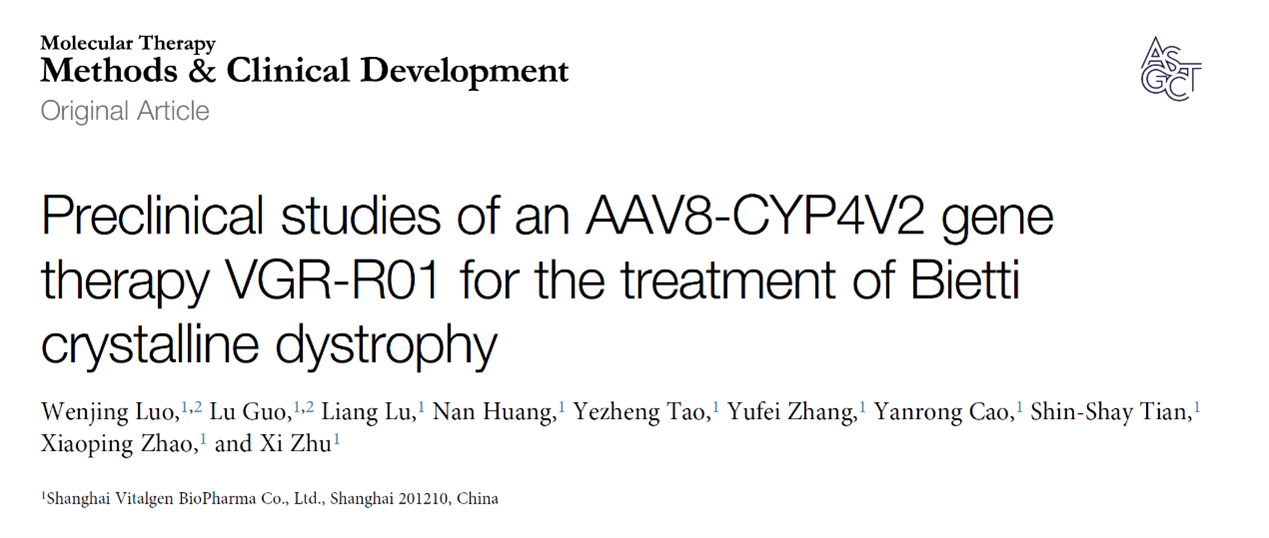Recently, two key research achievements of VGR-R01, developed by Shanghai Vitalgen Biompharma Co., LTD. (hereinafter referred to as "Vitalgen" or "the Company"), were published. One is a natural history study on Bietti crystalline dystrophy titled "Natural history of progressive vision loss in Bietti crystalline dystrophy: a model-based meta-analysis", and the other is the results from a non-clinical study of VGR-R01, "Preclinical Studies of an AAV8-CYP4V2 Gene Therapy VGR-R01 for the Treatment of Bietti Crystalline Dystrophy". These studies were published in the international ophthalmic journal *BMJ Open Ophthalmology* and the pharmacological journal *Molecular Therapy: Methods & Clinical Development* respectively. These milestones signify that VGR-R01 has achieved an internationally leading breakthrough in treating BCD, offering new hope to patients worldwide.
The research and development process of VGR-R01 can be traced back to March 2017. Professor Li Wei, together with Professor Hu Danning, the founder of the Ophthalmic Genetics Group of the Genetics Society of China, Professor Wei Wenbin from Beijing Tongren Hospital, Professor Sui Ruifang from Peking Union Medical College Hospital, and others, jointly determined that gene therapy for BCD would be selected as a topic for the National Key Research and Development Program. The research team led by Professor Li Wei from the Institute of Zoology, Chinese Academy of Sciences, successfully constructed the world's first Cyp4v3 (a mouse homologous gene of CYP4V2) deletion mouse model fed with a high-fat diet. This model demonstrated a dual BCD disease phenotype of fundus crystallization and decreased visual function. Meanwhile, the applicability of gene therapy for BCD was further verified through mouse experiments. The relevant research results were published in the international academic journal *Gene Therapy* in June 2020.
After Vitalgen was established in 2020, to break through the global blank in the BCD treatment field, the company built a full-chain innovation system spanning from basic research to commercialization. Based on previous scientific research achievements, the company completed the molecular optimization and non-clinical research of AAV carriers, overcame the technical challenges of subretinal injection preparations, and established a production system compliant with GMP standards. In 2022, investigator-initiated clinical trials (IIT) were launched to preliminarily verify the human safety and vision improvement signals of VGR-R01. In November of the same year, it obtained the implied approval for clinical trials from CDE. As of now, all subjects have been enrolled in the Phase III registration clinical trial, and VGR-R01 is expected to become the world's first approved therapeutic product for BCD.
Interpretation of Core Achievements
1. The first BCD natural history model was established to address clinical development challenges

As a rare disease, BCD has a relatively low prevalence, resulting in limited research data on its natural history. We successfully established a disease progression model based on BCVA changes. This model promoted researchers' understanding of the clinical characteristics and treatment efficacy evaluation of BCD. We hope this study will further contribute to the formulation of clinical development strategies and regulatory decisions for BCD in the future.
This meta-analysis was based on the individual data of BCD patients. Using the change in BCVA from baseline as the efficacy indicator, a disease progression model for BCD patients over time was established. The results showed that factors such as age of onset, gender, race, genotype, and family history had no significant impact on disease progression. The BCVA in BCD patients increased by 0.06 logarithm of the minimum angle of resolution (LogMAR) per year on average. However, more importantly, due to the general lack of awareness of BCD, in clinical practice, patients often seek medical treatment in the middle and late stages of the disease, and this is also the main population currently participating in gene therapy clinical trials. Therefore, for patients with poor vision and a long disease course, this model also indicates that the progression of vision loss is faster. The average annual visual acuity decreases by approximately 1 line (for patients with BCVA ≥ 0.5 LogMAR and a disease duration of ≥ 10 years, the BCVA increases by 0.09 LogMAR per year).
2. Non - clinical studies of VGR-R01 demonstrate the potential for precise treatment

VGR-R01 delivers the human CYP4V2 gene via subretinal injection. In vitro cellular studies have demonstrated that VGR-R01 induces dose - dependent expression of the CYP4V2 protein, significantly enhancing fatty acid hydroxylase activity and reducing lipid droplet accumulation in retinal pigment epithelium (RPE) cells. In vivo, in 8 - month - old Cyp4v3 - / - mice, VGR-R01 effectively improved electroretinogram (ERG) amplitudes.
VGR-R01 was well - tolerated in New Zealand rabbits and non - human primates (NHPs). Moreover, after subretinal administration, VGR-R01 was mainly distributed in ocular tissues, especially in the retina, with minimal systemic distribution, particularly in the gonads. Overall, these results strongly support the potential clinical application of VGR-R01 in treating BCD.
From uncovering the mechanisms of diseases to overcoming treatment barriers, Vitalgen, driven by "technological breakthroughs and patient needs", is bringing hope to BCD patients around the world. In the future, the company will continue to focus on the gene therapy field, aiming to transform more "untreatable" cases into "treatable and curable" ones.
About VGR-R01
VGR-R01 is a gene therapy product for recombinant adeno - associated viruses independently developed by Vitalgen. This product adopts the gene replacement therapy strategy. It uses the AAV8 capsid protein to mediate the transduction of RPE cells, transduces the CYP4V2 gene expression cassette into the cell nucleus, and expresses the CYP4V2 protein. This corrects the fatty acid metabolism disorder in the patient's retina, aiming to prevent or improve the structural and/or functional damage of RPE cells, photoreceptor cells, and the choroid, correct visual impairment, protect residual visual function, or delay vision deterioration.